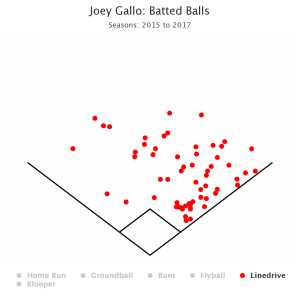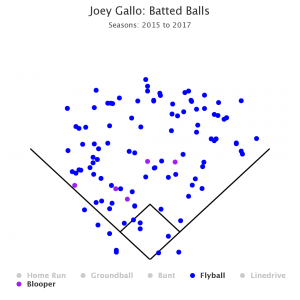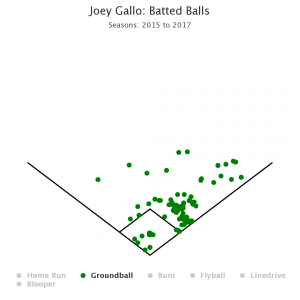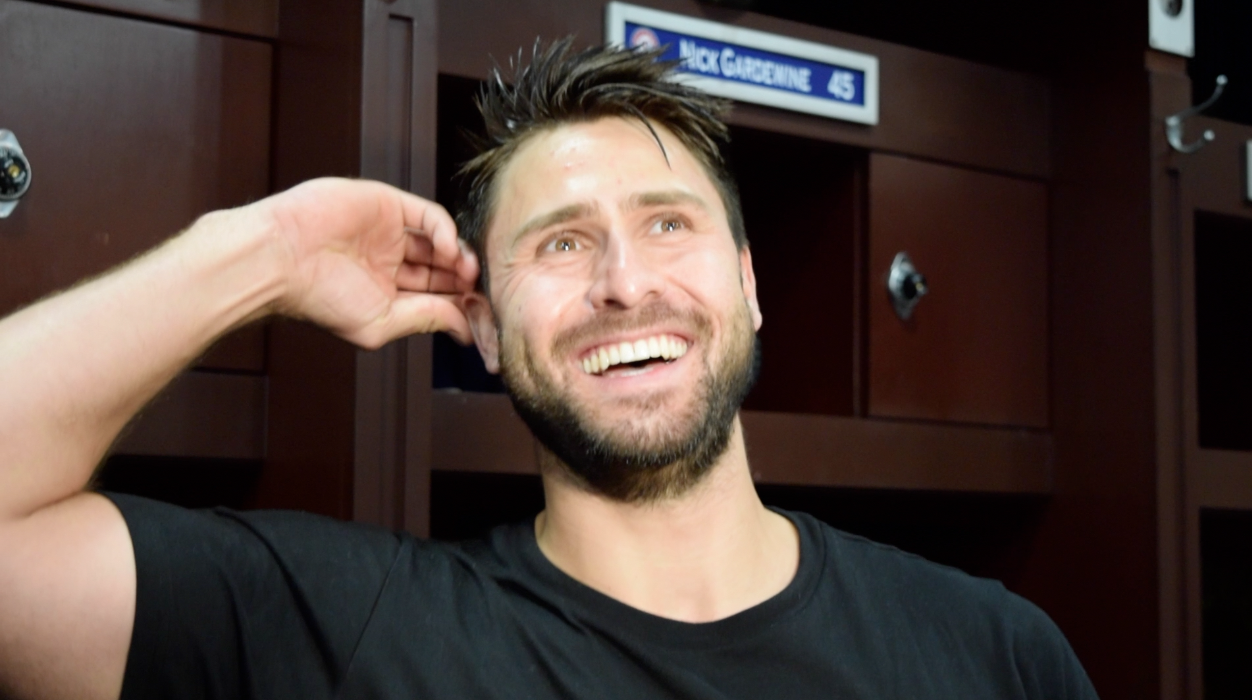In 2015, Joey Gallo hit a home run that I will remember forever. The Rangers were in Los Angeles, and Clayton Kershaw was on the mound. He threw a 1-1 slider to Gallo that stayed just high enough for Gallo to make solid contact. And when Gallo makes solid contact, well… we know what happens. Vin Scully describes the quickly-escaping ball as looking “like a marble.” Kershaw uncharacteristically loses his cool. Gallo hits a home dang run. This one went 435 feet to—of course—right field.
The location is no surprise: right field is where most of Gallo’s home runs land. Look, we brought charts!

Of Joey Gallo’s 48 career home runs, 36 of them have ended up right-of-dead-center. That’s not as pull-happy as, say, Mike Moustakas (33 of 38 went to actual right field), but it’s not as well-distributed as, say, Aaron Judge, whose spray chart looks like it was distributed by Bernie Sanders himself.
But I don’t want to spend too much time here. After all, who really cares if a home run goes to left or right field, so long as it clears the wall. This number will shock you: Joey Gallo’s batting average in the above chart is 1.000.
Where Gallo’s pull-heavy approach becomes interesting is in the other charts. Here, look at these line drives:

Now we’re talking about the balls that don’t go over the fence. The ones that—assuming they aren’t going 115 mph—can find a glove. But these are line drives, and Joey Gallo hits line drives very, very hard, which makes them very, very hard to catch. FanGraphs tells me that Gallo’s batting average on non-home-run line drives is .677 (that’s batting average, not slugging).
I’m sure it’s possible that some team could employ a shift that includes three right fielders and two first basemen, but until they do, I’m okay with Gallo hitting line drives wherever he wants. Let’s keep moving. Here’s where the news gets a little more dire.

As you can see, Joey Gallo distributes his pop-ups and bloops quite well. Check out that chart! They’re all over the place! Unfortunately, they are also not all over the …fence. When Gallo hits a pop-up or a bloop that doesn’t go for a home run, he hits just .107 (The upside: he does hit a lot of balls over the fence. When you include home runs in this number, his average goes up to .371). But wait, what’s this green stuff awaiting us below?

Ah, I found the problem. When Gallo hits a baseball on the ground, it almost inevitably turns the ball into a first-baseman-seeking missile. Gallo almost never goes opposite field on the ground, and when he does (you can play with the charts yourself here), it doesn’t usually result in a hit anyway. Gallo’s batting average on ground balls is .179. I won’t bet against Gallo finding a way to hit a home run on a ground ball, but so far, he’s 0-for-89 in that quest.
So what does this mean? A couple of things that are pretty obvious. One, if he doesn’t adjust, teams know that they can shift him pretty severely, especially in the infield. But two, it’s not just about being able to hit the ball the opposite way more, it’s being able to hit the ball well the opposite way. When Gallo hits line drives, it doesn’t matter where they go. When he hits the ball 400′, there’s no shift that can stop him.
As much as “hitting the ball to the opposite field”, Gallo’s improvement in 2018 will be in converting more of those pulled ground balls and evenly-distributed pop-ups into line drives. Gallo knows that. Listen to him talking this week about what he’s working on this offseason:
Did you hear the key word there? Authority.
And sure, he mentioned a “hit to the shortstop to start a rally”. I’m sure he means “tony he shortstop position, while the actual shortstop is playing Other First Baseman”. Probably. I hope.
Last year, we were asking if Joey Gallo could overcome his horrendous 2016 (wherein he hit .040) and play at the big league level. This year, after a 41-home-run season, we’re asking if the impossible is possible: can Gallo have another year of exponential improvement?
He thinks so. And he thinks he has a plan. Let’s see.

Kolby Kerr says
I’m torn on Joey’s development. On the one hand, we would want him to focus on becoming this well-rounded, hit-it-to-all-fields guy who can shorten up his swing when he needs to. Get that average up just a tick, increase contact, keep hitting dingers, etc.
On the other hand, maybe he is a one-dimensional player and that one dimension exists on a plane of reality beyond our reckoning. Maybe the best thing is to say, “Swing away, Joe,” and watch him become the weirdest valuable player in baseball. Maybe anything else just complicates that and leads to what we saw in 2016—a guy trying to be something he isn’t and afraid that what he is won’t be good enough.
I’m all-in on Plan A, and I love this article, but I’m fearful that trying to take one step forward will lead to two steps back. Either way, he’ll still be the most exciting at-bat in any inning.
Levi Weaver says
I had the same thought, but based on what I’ve heard him say in the past, I think the organization is well aware that he is unique. He credited Mashore and Banister both with telling him “don’t worry about the strikeouts, just go be Joey Gallo and hit the ball a mile”. I don’t think this is a change in approach so much as it is “keep being you, just add this to keep them honest.”
fireovid says
Actually from what I’ve seen, Kershaw, an intense competitor, is visibly upset a higher percentage of the time than most when he gives up a run, which isn’t that often. Or a home run to a lefty, which is almost never. Yeah that was memorable.
Levi Weaver says
I’ve seen him get feisty before, but that level of just straight losing it and throwing a tantrum in the dugout was a new one for me. Granted, I’m watching the Rangers for 162 a year, so I don’t get to watch Kershaw as much as I’d like.